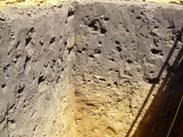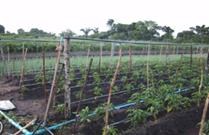Soil fertility
Biochars effectiveness has been proven on various soil types as well as in intensive horticulture in greenhouses. It can be used to improve poor-quality farm land as well as land that has depleted soil organic carbon contents. It helps attract and maintain beneficial microbes as well as balance out soil acidity.
Historically, sedentary farmers had two basic choices: deplete their carbon stocks—rendering their fields infertile—or find ways to maintain carbon. All too often, intensive agricultural land use throughout the world has caused physical and chemical degradation of soil, erosion, and losses of soil organic carbon.
However, in some locations, nutrient-rich materials have been deposited into soil, maintaining and actually improving fertility over centuries. One prominent example is Terra Preta de Índio. This dark, fertile soil is found throughout the Amazon Basin lowlands, an otherwise infertile region. It contains high concentrations of charcoal (biochar). These soils were enriched with nutrient rich bones and charcoal. As a result, the most infertile soils were transferred into most productive soils. These soils have been created centuries and millennia ago, but are still valued by the local population for their sustained soil fertility.
 |
 |
|
Dark terra preta horizon above |
Cash crop production on man-made |
Similar to terra preta, Chernozem (“black earth”) soils are not man-made, but are also characterized by black surface horizons, rich in organic matter and are the world’s most productive soils. They are typically found in grass steppes, where grassland fires have contributed a high content of pyrogenic carbon (biochar). Chernozems fall into the U.S. soil classification mollisols, which occur extensively in prairie regions such as the Great Plains.